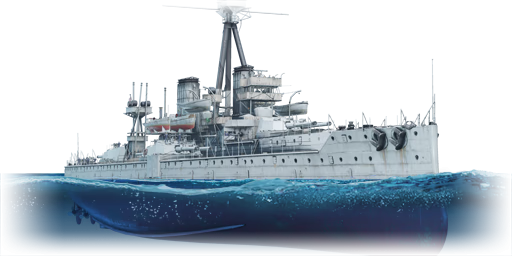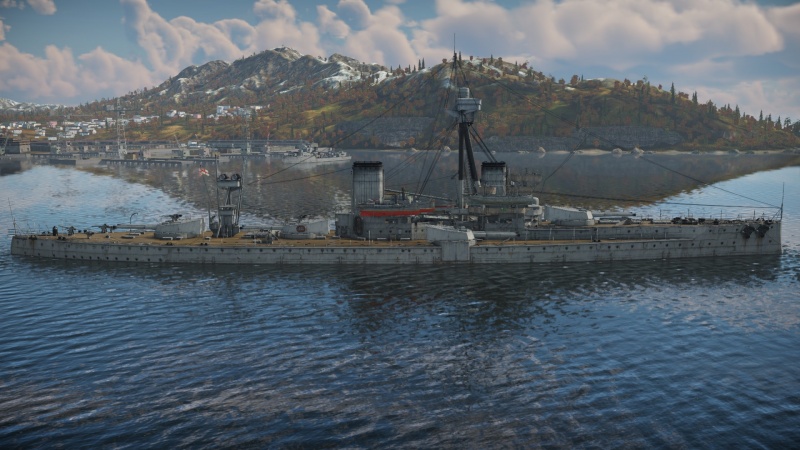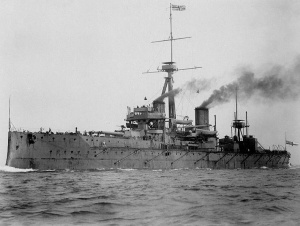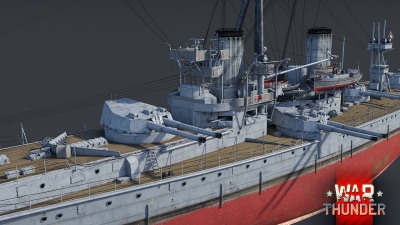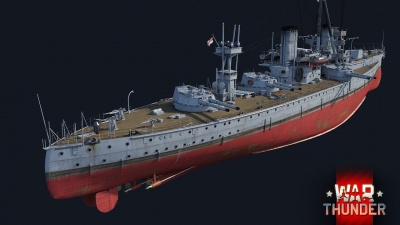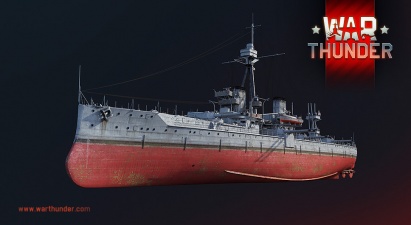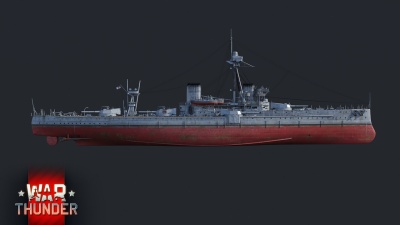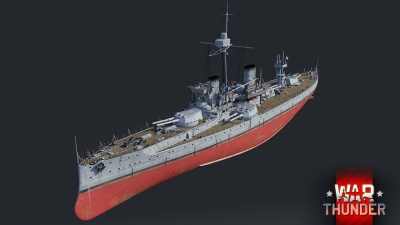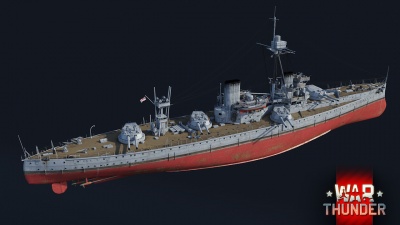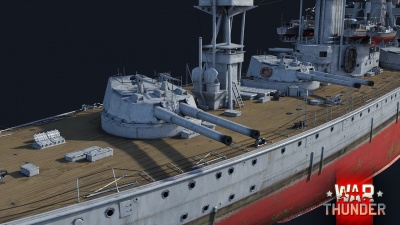Difference between revisions of "HMS Dreadnought"
(Tag: Visual edit) |
(→Ammunition: Converted to transclusion) |
||
| (17 intermediate revisions by 9 users not shown) | |||
| Line 1: | Line 1: | ||
| − | {{Specs-Card|code=uk_battleship_dreadnought}} | + | {{Specs-Card |
| + | |code=uk_battleship_dreadnought | ||
| + | |images={{Specs-Card-Image|GarageImage_{{PAGENAME}}.jpg}} | ||
| + | }} | ||
== Description == | == Description == | ||
<!-- ''In the first part of the description, cover the history of the ship's creation and military application. In the second part, tell the reader about using this ship in the game. Add a screenshot: if a beginner player has a hard time remembering vehicles by name, a picture will help them identify the ship in question.'' --> | <!-- ''In the first part of the description, cover the history of the ship's creation and military application. In the second part, tell the reader about using this ship in the game. Add a screenshot: if a beginner player has a hard time remembering vehicles by name, a picture will help them identify the ship in question.'' --> | ||
| − | |||
| − | |||
The '''{{Specs|name}}''' is a rank {{Specs|rank}} British battleship {{Battle-rating}}. It was introduced in [[Update "New Power"]]. | The '''{{Specs|name}}''' is a rank {{Specs|rank}} British battleship {{Battle-rating}}. It was introduced in [[Update "New Power"]]. | ||
| + | |||
| + | HMS Dreadnought is the battleship that launched the dreadnought revolution when built by First Sea Lord Jackie Fisher in 1906, turning every previous battleship obsolete to the point that they are now collectively referred to as pre-dreadnoughts and Dreadnought became the official name of this new class of warship. There were four main aspects of Dreadnought responsible for this. | ||
| + | |||
| + | Firepower: Dreadnought was armed with 10x 305 mm cannons and could broadside with 8 of them in an era where a battleship could have half that and be considered heavily armed. The design did away with the old practice of having a vast number of secondary guns of various calibres in favour of having the largest number of heavy guns as possible, which could fire further and hit harder than the previous masses of secondaries. What's the point in covering your ship in medium to small guns that could theoretically savage an opponent up close when the opponent can blast you out of the water before you can even begin to get close enough? | ||
| + | |||
| + | Accuracy: The vessel was one of the first to be equipped with a modern fire control system that could electrically transmit firing instructions to the turrets, which enabled it to make effective use of the large main guns which would have been hopelessly inaccurate just a few decades previously. | ||
| + | |||
| + | Speed: This was the first battleship to be constructed with revolutionary new steam turbines, rather than the old triple expansion reciprocating steam engines. Steam turbines were more efficient and compact, enabling higher speeds. They ran much more smoothly, making maintenance and general life below decks easier. They were capable of running at full power for much longer periods of time, whereas the old reciprocating steam engines were liable to run themselves to pieces if used to the same extent. This made Dreadnought the fastest battleship in the world and could maintain its top speed far longer than any other, enabling the ship to control the distance battle would be fought at and keep older battleships far away enough so that their their secondary guns were useless. | ||
| + | |||
| + | With naval experts estimating that she could have easily duelled two, maybe three or four pre-dreadnought battleships simultaneously, Dreadnought represented a quantum leap in capability over all previous capital warships and further established Britain's position as the leading world naval power at that time. Fittingly, HMS Dreadnought is also one of the first battleships to be introduced into the game. | ||
== General info == | == General info == | ||
=== Survivability and armour === | === Survivability and armour === | ||
| + | {{Specs-Fleet-Armour}} | ||
<!-- ''Talk about the vehicle's armour. Note the most well-defended and most vulnerable zones, e.g. the ammo magazine. Evaluate the composition of components and assemblies responsible for movement and manoeuvrability. Evaluate the survivability of the primary and secondary armaments separately. Don't forget to mention the size of the crew, which plays an important role in fleet mechanics. Save tips on preserving survivability for the "Usage in battles" section. If necessary, use a graphical template to show the most well-protected or most vulnerable points in the armour.'' --> | <!-- ''Talk about the vehicle's armour. Note the most well-defended and most vulnerable zones, e.g. the ammo magazine. Evaluate the composition of components and assemblies responsible for movement and manoeuvrability. Evaluate the survivability of the primary and secondary armaments separately. Don't forget to mention the size of the crew, which plays an important role in fleet mechanics. Save tips on preserving survivability for the "Usage in battles" section. If necessary, use a graphical template to show the most well-protected or most vulnerable points in the armour.'' --> | ||
| − | + | HMS Dreadnought has a reasonably thick armoured belt for a first-generation dreadnought battleship. It is 279 mm thick below the waterline and 203 mm above the waterline, thinning out to 152 mm towards the bow and 102 mm towards the stern. The Dreadnought also features a "turtleback" citadel, with angled 70 mm and 76 mm plates behind the main belt designed to deflect shells that penetrate the main belt. The bow end of the citadel is protected by an angled 102 mm plate, while the stern end is protected by a 203 mm vertical upper plate and 102 mm angled lower plate. The upper deck plating is 19 mm thick and the lower deck plating is 45 mm thick amidships, 38 mm over the bow, and 51 mm over the stern and steering gear. | |
| + | |||
| + | The main gun turrets are protected by angled 279.4 mm plating around the front and sides, 330 mm plating on the rear, and 76.2 mm plating on the turret roof and the bottom. The bow, stern, and wing turret barbettes are 279 mm thick facing outwards from the ship and 203 mm facing inwards, while the amidships turret has 203 mm all-round barbette protection. | ||
| + | |||
| + | The main gun magazines are located well below the waterline and are further protected by additional 51 mm and 25 mm plates, with 102 mm plating covering the outward facing sides of the wing turret ammunition magazines. | ||
| + | |||
| + | The bridge is protected by an armoured conning tower with 279 mm thick sides and a 76 mm roof. | ||
| + | |||
| + | Dreadnought also has additional protection amidships from her coal bunkers, which provide the equivalent of about 40 mm of steel. | ||
| + | |||
| + | Dreadnought has a small crew complement for a battleship, along with the British [[HMS Colossus|Colossus]]. | ||
=== Mobility === | === Mobility === | ||
| + | {{Specs-Fleet-Mobility}} | ||
<!-- ''Write about the ship's mobility. Evaluate its power and manoeuvrability, rudder rerouting speed, stopping speed at full tilt, with its maximum forward and reverse speed.'' --> | <!-- ''Write about the ship's mobility. Evaluate its power and manoeuvrability, rudder rerouting speed, stopping speed at full tilt, with its maximum forward and reverse speed.'' --> | ||
| − | + | Dreadnought has about average mobility for a first-generation dreadnought. As a battleship, she is displaces much more than cruisers and destroyers, and thus her acceleration and top speed are much lower. Her handling and manoeuvrability are about average for a battleship. | |
{{NavalMobility}} | {{NavalMobility}} | ||
| + | |||
| + | === Modifications and economy === | ||
| + | {{Specs-Economy}} | ||
== Armament == | == Armament == | ||
| + | {{Specs-Fleet-Armaments}} | ||
=== Primary armament === | === Primary armament === | ||
| + | {{Specs-Fleet-Primary}} | ||
<!-- ''Provide information about the characteristics of the primary armament. Evaluate their efficacy in battle based on their reload speed, ballistics and the capacity of their shells. Add a link to the main article about the weapon: <code><nowiki>{{main|Weapon name (calibre)}}</nowiki></code>. Broadly describe the ammunition available for the primary armament, and provide recommendations on how to use it and which ammunition to choose.'' --> | <!-- ''Provide information about the characteristics of the primary armament. Evaluate their efficacy in battle based on their reload speed, ballistics and the capacity of their shells. Add a link to the main article about the weapon: <code><nowiki>{{main|Weapon name (calibre)}}</nowiki></code>. Broadly describe the ammunition available for the primary armament, and provide recommendations on how to use it and which ammunition to choose.'' --> | ||
{{main|305 mm/45 Mark X (305 mm)}} | {{main|305 mm/45 Mark X (305 mm)}} | ||
| − | + | Dreadnought is armed with 10x 305 mm BL 12-inch Mark X main guns located in five twin turrets. Two of these are wing turrets located amidships that can only fire to one side each, thus her actual maximum broadside consists of only eight main guns from four twin turrets. She can also bring six guns to bear directly ahead or astern from the wing turrets (which have 180 degrees of traverse) and the bow/stern turret. The turrets have fairly good traverse arcs towards the bow of the ship (the two rear turrets can traverse up to 150 degrees to each side) and somewhat worse towards the stern (the bow turret can only traverse up to 141 degrees to each side). The guns have a maximum rate of fire of 2 rounds/minute per gun with an aced crew. | |
| + | |||
| + | Ammunition types consist of HE Mark IIa, APC Mark VIa, and CPC Mark VIIa (semi-armour piercing). The HE shell has the second largest explosive filler of any 305 mm/12-inch shell at ~53 kg of TNT equivalent, with only the SAP shell of the Russian/Soviet 305 mm used by the [[Parizhskaya kommuna|Parizhskaya Kommuna]] and [[Imperatritsa Mariya]] having more explosive (~55 kg TNT). It is capable of causing immense damage to destroyers, most cruisers, and other lightly armoured targets. By contrast, the APC shell is the lightest of the 305 mm AP projectiles, has a relatively small filler of only ~12 kg TNT, and has the lowest penetration of the AP shells its calibre. The CPC SAP shell is a compromise between the explosive power of the HE shell and the penetration of the APC shell. It has enough penetration to go through anything other than thick battleship belt armour, and has ~36 kg of TNT. | ||
| + | |||
| + | Dreadnought's rangefinder is quite poor, having a measurement accuracy of only 86% upgraded, reflecting its age. | ||
| + | |||
| + | {{:305 mm/45 Mark X (305 mm)/Ammunition|305 mm Mark IIa HE, 305 mm Mark VIa APC, 305 mm Mark VIIa SAPCBC}} | ||
=== Secondary armament === | === Secondary armament === | ||
| + | {{Specs-Fleet-Secondary}} | ||
<!-- ''Some ships are fitted with weapons of various calibres. Secondary armaments are defined as weapons chosen with the control <code>Select secondary weapon</code>. Evaluate the secondary armaments and give advice on how to use them. Describe the ammunition available for the secondary armament. Provide recommendations on how to use them and which ammunition to choose. Remember that any anti-air armament, even heavy calibre weapons, belong in the next section. If there is no secondary armament, remove this section.'' --> | <!-- ''Some ships are fitted with weapons of various calibres. Secondary armaments are defined as weapons chosen with the control <code>Select secondary weapon</code>. Evaluate the secondary armaments and give advice on how to use them. Describe the ammunition available for the secondary armament. Provide recommendations on how to use them and which ammunition to choose. Remember that any anti-air armament, even heavy calibre weapons, belong in the next section. If there is no secondary armament, remove this section.'' --> | ||
{{main|76 mm/50 12pdr 18cwt QF Mark I (76 mm)}} | {{main|76 mm/50 12pdr 18cwt QF Mark I (76 mm)}} | ||
| − | ' | + | Dreadnought's secondary armament consists of 18 QF 12-pounder Mark I in single mounts. These are 76 mm guns, thus the Dreadnought's secondary battery of the smallest of any battleship in the game. Each gun has a rate of fire of 15 rounds/gun with an aced crew. Each main gun turret has two of these on its roof, with the remaining ten guns scattered around the ship's hull and superstructure. These guns can only elevate up to 20 degrees and only fire CP semi-AP shells, thus are only useful against surface targets. The CP shell has a small filler of only 520 g TNT equivalent and low penetration, thus it will struggle to do much damage against anything other than coastal craft. |
| + | |||
| + | {{:76 mm/50 12pdr 18cwt QF Mark I (76 mm)/Ammunition|76 mm CP}} | ||
=== Anti-aircraft armament === | === Anti-aircraft armament === | ||
| + | {{Specs-Fleet-AA}} | ||
<!-- ''An important part of the ship's armament responsible for air defence. Anti-aircraft armament is defined by the weapon chosen with the control <code>Select anti-aircraft weapons</code>. Talk about the ship's anti-air cannons and machine guns, the number of guns and their positions, their effective range, and about their overall effectiveness – including against surface targets. If there are no anti-aircraft armaments, remove this section.'' --> | <!-- ''An important part of the ship's armament responsible for air defence. Anti-aircraft armament is defined by the weapon chosen with the control <code>Select anti-aircraft weapons</code>. Talk about the ship's anti-air cannons and machine guns, the number of guns and their positions, their effective range, and about their overall effectiveness – including against surface targets. If there are no anti-aircraft armaments, remove this section.'' --> | ||
{{main|76 mm/45 QF 3in 20cwt HA Mark I (76 mm)}} | {{main|76 mm/45 QF 3in 20cwt HA Mark I (76 mm)}} | ||
| − | + | Dreadnought has two anti-aircraft 76 mm QF 12-pounder 20-cwt HA Mark I guns. These have a low rate of fire of only 12 rounds/minute with an aced crew, and there is no option to use time-fused shells, making them less effective against aircraft. | |
| − | === | + | === Additional armament === |
| − | <!-- '' | + | {{Specs-Fleet-Additional}} |
| + | <!-- ''Describe the available additional armaments of the ship: depth charges, mines, torpedoes. Talk about their positions, available ammunition and launch features such as dead zones of torpedoes. If there is no additional armament, remove this section.'' --> | ||
{{main|R.G.F. Mark VI** (450 mm)}} | {{main|R.G.F. Mark VI** (450 mm)}} | ||
| − | + | Dreadnought has four fixed 457 mm/18-inch underwater torpedo tubes, two in the bow and two in the stern, with two facing port and two facing starboard. She can carry up to 30 Mark VI** torpedoes. These are fairly slow (56 km/h) and have a short range of only 5.49 km. The warhead is also quite small, at only 134 kg TNT. | |
== Usage in battles == | == Usage in battles == | ||
<!-- ''Describe the technique of using this ship, the characteristics of her use in a team and tips on strategy. Abstain from writing an entire guide – don't try to provide a single point of view, but give the reader food for thought. Talk about the most dangerous opponents for this vehicle and provide recommendations on fighting them. If necessary, note the specifics of playing with this vehicle in various modes (AB, RB, SB).'' --> | <!-- ''Describe the technique of using this ship, the characteristics of her use in a team and tips on strategy. Abstain from writing an entire guide – don't try to provide a single point of view, but give the reader food for thought. Talk about the most dangerous opponents for this vehicle and provide recommendations on fighting them. If necessary, note the specifics of playing with this vehicle in various modes (AB, RB, SB).'' --> | ||
| − | + | As the first dreadnought battleship, and therefore the oldest one, Dreadnought has its strengths but also some prominent weaknesses stemming from being the first of its kind. She has a fairly powerful main battery of ten guns, especially when shooting the powerful HE or SAP, but only eight of these can be used against a target at most thanks to her wing turret configuration. However, with some slight manoeuvring, she can use six guns on targets directly ahead or astern thanks to these wing turrets, while presenting the smallest target possible. The APC shell is weak for a battleship's 305 mm-gun, but this is compensated for with sheer explosive power from the HE and SAP shells along with the fires they cause. | |
| + | |||
| + | Her secondary battery is the weakest of any battleship in the game, relying exclusively on the 76 mm guns. These are fairly ineffective against even destroyers, and only really effective against small coastal craft. The anti-aircraft armament is about what can be expected for a World War I era battleship: virtually non-existent. | ||
| − | + | The Dreadnought's survivability is generally quite good against anything other than the most powerful battleship guns. Her overall protection level is quite decent, and can be improved even further with angling. However, her small crew complement is a significant drawback, especially vulnerable towards fires. | |
| − | |||
| − | |||
| − | |||
| − | |||
| − | |||
| − | |||
| − | |||
| − | |||
| − | |||
| − | |||
| − | |||
| − | |||
| − | |||
| − | |||
| − | |||
| − | |||
| − | |||
| − | |||
| − | |||
| − | |||
| − | |||
| − | |||
| − | |||
| − | |||
| − | |||
| − | |||
| − | |||
| − | |||
| − | |||
| − | |||
| − | |||
| − | |||
| − | |||
| − | |||
| − | |||
| − | |||
| − | |||
| − | |||
| − | |||
=== Pros and cons === | === Pros and cons === | ||
<!-- ''Summarise and briefly evaluate the vehicle in terms of its characteristics and combat effectiveness. Mark its pros and cons in the bulleted list. Try not to use more than 6 points for each of the characteristics. Avoid using categorical definitions such as "bad", "good" and the like - use substitutions with softer forms such as "inadequate" and "effective".'' --> | <!-- ''Summarise and briefly evaluate the vehicle in terms of its characteristics and combat effectiveness. Mark its pros and cons in the bulleted list. Try not to use more than 6 points for each of the characteristics. Avoid using categorical definitions such as "bad", "good" and the like - use substitutions with softer forms such as "inadequate" and "effective".'' --> | ||
| − | |||
'''Pros:''' | '''Pros:''' | ||
| − | * | + | * Large HE and SAP shell explosive fillers |
| − | * | + | * Effective main gun magazine protection |
| − | * | + | * Heavily armoured bridge |
| − | + | * Can angle quite heavily when shooting at targets in the frontal aspect | |
| − | * | + | * Large coal bunkers providing additional protection amidships |
'''Cons:''' | '''Cons:''' | ||
| − | * | + | * Inadequate secondary and non-existent anti-aircraft batteries |
| − | * | + | * Inaccurate rangefinder |
| − | * | + | * Can only bring 8 out of 10 main guns to bear on a target at most |
| − | + | * AP shell has relatively low penetration and small filler for its calibre | |
| − | * | + | * Small crew complement |
== History == | == History == | ||
<!-- ''Describe the history of the creation and combat usage of the ship in more detail than in the introduction. If the historical reference turns out to be too long, take it to a separate article, taking a link to the article about the ship and adding a block "/History" (example: <nowiki>https://wiki.warthunder.com/(Ship-name)/History</nowiki>) and add a link to it here using the <code>main</code> template. Be sure to reference text and sources by using <code><nowiki><ref></ref></nowiki></code>, as well as adding them at the end of the article with <code><nowiki><references /></nowiki></code>. This section may also include the ship's dev blog entry (if applicable) and the in-game encyclopedia description (under <code><nowiki>=== In-game description ===</nowiki></code>, also if applicable).'' --> | <!-- ''Describe the history of the creation and combat usage of the ship in more detail than in the introduction. If the historical reference turns out to be too long, take it to a separate article, taking a link to the article about the ship and adding a block "/History" (example: <nowiki>https://wiki.warthunder.com/(Ship-name)/History</nowiki>) and add a link to it here using the <code>main</code> template. Be sure to reference text and sources by using <code><nowiki><ref></ref></nowiki></code>, as well as adding them at the end of the article with <code><nowiki><references /></nowiki></code>. This section may also include the ship's dev blog entry (if applicable) and the in-game encyclopedia description (under <code><nowiki>=== In-game description ===</nowiki></code>, also if applicable).'' --> | ||
[[File:Dreadnought, 1906.jpg|thumb|HMS Dreadnought underway in 1906.]] | [[File:Dreadnought, 1906.jpg|thumb|HMS Dreadnought underway in 1906.]] | ||
| − | + | '''HMS Dreadnought''', sole ship of her class, was a dreadnought battleship of the Royal Navy. Launched in 1906, the Dreadnought was a revolutionary battleship design featuring a large main battery of ten 12-inch (305 mm) guns in five twin turrets. Her name, "Dreadnought", would be used to describe all of the battleships built after her construction and with similar design. Dreadnought's construction led to a global arms race, as countries like Germany, Japan and the United States scrambled to build dreadnoughts of their own. HMS Dreadnought served during the First World War, but saw little service; despite her design as a battleship, her only action was the ramming and sinking of a German U-Boat. The action made Dreadnought the only battleship confirmed to have sunk a submarine. Dreadnought did not participate in the Battle of Jutland (as she was being refitted), and saw little service for the rest of the war. She was reduced to reserve in 1919, and scrapped several years later.<ref name=":0">Suciu, P. (2020)</ref><ref name=":1">Editors of Britannica. (2020)</ref> | |
=== Design and development === | === Design and development === | ||
| − | In 1905, Sir John "Jackie" Fisher, First Sea Lord of the Royal Navy, began the process of designing a new class of battleship.<ref name=":0" /> This design would become one of the most revolutionary developments in naval history. The new battleship would feature an "all-big-gun" armament; this was a stark contrast to the existing battleship designs, which had a smaller big-gun armament and numerous secondary guns. The vessel was named | + | In 1905, Sir John "Jackie" Fisher, First Sea Lord of the Royal Navy, began the process of designing a new class of battleship.<ref name=":0" /> This design would become one of the most revolutionary developments in naval history. The new battleship would feature an "all-big-gun" armament; this was a stark contrast to the existing battleship designs, which had a smaller big-gun armament and numerous secondary guns. The vessel was named Dreadnought, meaning "fear-nothing".<ref name=":0" /> The ship was also fitted with steam turbines, a novel engine type that made the ship faster than all existing battleship designs.<ref name=":0" /> |
| − | The Dreadnought was armed with a main battery of ten 12-inch guns mounted in five twin turrets. It also carried a substantial amount of secondary guns. The ship displaced 18,000 tons, and was 160 metres long.<ref name=":1" /> Powered by the new steam turbines, Dreadnought could make 21 knots, which made it faster than any existing battleship designs. Dreadnought was ordered in October of 1905, and launched in early 1906. It was formally commissioned on December | + | The Dreadnought was armed with a main battery of ten 305 mm/12-inch guns mounted in five twin turrets. It also carried a substantial amount of secondary guns. The ship displaced 18,000 tons, and was 160 metres long.<ref name=":1" /> Powered by the new steam turbines, Dreadnought could make 39km/h or 21 knots, which made it faster than any existing battleship designs. Dreadnought was ordered in October of 1905, and launched in early 1906, a blatant show of the Royal Navy's construction capabilities. It was formally commissioned on the 2nd of December, 1906. |
=== Operational History === | === Operational History === | ||
| − | Dreadnought's construction was a huge shock to the naval community, as the ship far outclassed any existing battleship design. As a result, the ship lent its name to all new battleship designs - these would be collectively known as "dreadnoughts". Any battleships built before dreadnought were known as "Pre-dreadnoughts".<ref name=":0" /><ref name=":1" /> | + | Dreadnought's construction was a huge shock to the naval community, as the ship far outclassed any existing battleship design. As a result, the ship lent its name to all new battleship designs - these would be collectively known as "dreadnoughts". Any battleships built before dreadnought were known as "Pre-dreadnoughts".<ref name=":0" /><ref name=":1" /> Dreadnought's construction also triggered a naval arms race, as numerous nations raced to build their own dreadnoughts; these included the German [[SMS Helgoland|Nassau]]-class, Japanese [[IJN Settsu|Kawachi]]-class and American South-Carolina class. |
| + | |||
| + | In part because of the arms race it caused, Dreadnought was made obsolete by the rapid progress of naval design.<ref name=":0" /> Before the start of the First World War, super-dreadnoughts emerged; these ships were far more advanced than the Dreadnought, incorporating innovations such as a centreline-mounted main battery. Dreadnought, being relatively obsolete, saw little service during the First World War; it didn't participate in the Battle of Jutland, nor any other surface engagements. Dreadnought's only action occurred in March of 1915, when she rammed and sank a German U-Boat;<ref name=":1" /> this made her the only battleship known to have sunk a submarine, except arguably for HMS Warspite, which sank a German submarine with her float plane in WW2. Due to her obsolescence, Dreadnought was relegated to reserve in 1919; she was sold for scrapping, and scrapped in 1923.<ref name=":0" /> | ||
| + | |||
| + | === [[wt:en/news/6914-development-hms-dreadnought-the-face-of-a-new-generation-en|Devblog]] === | ||
| + | At the turn of the century, notable developments in all aspects of naval warfare could be observed, ranging from gunnery practices over torpedo design to propulsion systems. HMS Dreadnought, as it would become known, was developed to take advantage of these latest developments, in particular, by incorporating a steam turbine propulsion system and by adopting a so-called 'all-big-gun' weapons arsenal. | ||
| + | |||
| + | The latter in particular, meant a unified calibre main battery, thus moving away from the common practice of installing multiple calibres of weapons aboard a large warship, which proved increasingly inefficient. In a similar fashion, HMS Dreadnought was to become the first warship to be fitted with steam turbines, giving her a greater speed than any comparable warship at the time. | ||
| + | |||
| + | HMS Dreadnought was laid down in October 1905, launched in February 1906 and, after undergoing sea trials, commissioned into service with the Royal Navy's Home Fleet as its flagship in December - just fifteen months after it was laid down. Immediately after entering service, HMS Dreadnought virtually rendered all older battleships obsolete due to its advanced design, thus also kicking off a naval arms race, most notably between Britain and Germany. | ||
| + | |||
| + | During WWI, HMS Dreadnought saw little action, in fact missing the critical Battle of Jutland in 1916 as the ship was carrying out other duties. Although designed to defeat other battleships, HMS Dreadnought's most famous encounter with hostile forces was the sinking of the German U-Boat U-29 by ramming it in 1915! | ||
| − | + | After the war, HMS Dreadnought became surplus to requirements as more and more modern battleships took her place. After a brief postwar service, HMS Dreadnought was sold for scrap in May 1921. Although the mighty warship was ultimately broken apart, its construction represented such a milestone in naval development that history remembers it as nothing short of a naval legend. | |
== Media == | == Media == | ||
<!-- ''Excellent additions to the article would be video guides, screenshots from the game, and photos.'' --> | <!-- ''Excellent additions to the article would be video guides, screenshots from the game, and photos.'' --> | ||
| − | + | ||
| + | ;Skins | ||
| + | |||
| + | * [https://live.warthunder.com/feed/camouflages/?vehicle=uk_battleship_dreadnought Skins and camouflages for the {{PAGENAME}} from live.warthunder.com.] | ||
| + | |||
| + | ;Images | ||
| + | <gallery mode="packed" caption="HMS Dreadnought Devblog Images" heights="150"> | ||
| + | File:HMS Dreadnought WTWallpaper 001.jpg| | ||
| + | File:HMS Dreadnought WTWallpaper 002.jpg| | ||
| + | File:HMS Dreadnought WTWallpaper 003.jpg| | ||
| + | File:HMS Dreadnought WTWallpaper 004.jpg| | ||
| + | File:HMS Dreadnought WTWallpaper 005.jpg| | ||
| + | File:HMS Dreadnought WTWallpaper 006.jpg| | ||
| + | File:HMS Dreadnought WTWallpaper 007.jpg| | ||
| + | </gallery> | ||
== See also == | == See also == | ||
| Line 140: | Line 166: | ||
* ''topic on the official game forum;'' | * ''topic on the official game forum;'' | ||
* ''other literature.'' --> | * ''other literature.'' --> | ||
| − | === | + | |
| + | * [[wt:en/news/6914-development-hms-dreadnought-the-face-of-a-new-generation-en|[Devblog] HMS Dreadnought: The Face of a New Generation]] | ||
| + | |||
| + | === References === | ||
| + | |||
| + | ;Citations | ||
<references /> | <references /> | ||
| − | + | ;Bibliography | |
* Suciu, P. (2020, April 07). HMS Dreadnought Made All Other Battleships Obsolete. Retrieved November 28, 2020, from <nowiki>https://nationalinterest.org/blog/buzz/hms-dreadnought-made-all-other-battleships-obsolete-141337</nowiki> | * Suciu, P. (2020, April 07). HMS Dreadnought Made All Other Battleships Obsolete. Retrieved November 28, 2020, from <nowiki>https://nationalinterest.org/blog/buzz/hms-dreadnought-made-all-other-battleships-obsolete-141337</nowiki> | ||
* Editors of Britannica. (2020). Dreadnought. Retrieved November 28, 2020, from <nowiki>https://www.britannica.com/topic/Dreadnought-British-battleship</nowiki> | * Editors of Britannica. (2020). Dreadnought. Retrieved November 28, 2020, from <nowiki>https://www.britannica.com/topic/Dreadnought-British-battleship</nowiki> | ||
| − | + | {{ShipManufacturer Portsmouth}} | |
| − | |||
{{Britain battleships}} | {{Britain battleships}} | ||
Latest revision as of 19:23, 22 February 2023
Contents
Description
The Dreadnought-class, HMS Dreadnought (00), 1917 is a rank V British battleship with a battle rating of 6.3 (AB/RB/SB). It was introduced in Update "New Power".
HMS Dreadnought is the battleship that launched the dreadnought revolution when built by First Sea Lord Jackie Fisher in 1906, turning every previous battleship obsolete to the point that they are now collectively referred to as pre-dreadnoughts and Dreadnought became the official name of this new class of warship. There were four main aspects of Dreadnought responsible for this.
Firepower: Dreadnought was armed with 10x 305 mm cannons and could broadside with 8 of them in an era where a battleship could have half that and be considered heavily armed. The design did away with the old practice of having a vast number of secondary guns of various calibres in favour of having the largest number of heavy guns as possible, which could fire further and hit harder than the previous masses of secondaries. What's the point in covering your ship in medium to small guns that could theoretically savage an opponent up close when the opponent can blast you out of the water before you can even begin to get close enough?
Accuracy: The vessel was one of the first to be equipped with a modern fire control system that could electrically transmit firing instructions to the turrets, which enabled it to make effective use of the large main guns which would have been hopelessly inaccurate just a few decades previously.
Speed: This was the first battleship to be constructed with revolutionary new steam turbines, rather than the old triple expansion reciprocating steam engines. Steam turbines were more efficient and compact, enabling higher speeds. They ran much more smoothly, making maintenance and general life below decks easier. They were capable of running at full power for much longer periods of time, whereas the old reciprocating steam engines were liable to run themselves to pieces if used to the same extent. This made Dreadnought the fastest battleship in the world and could maintain its top speed far longer than any other, enabling the ship to control the distance battle would be fought at and keep older battleships far away enough so that their their secondary guns were useless.
With naval experts estimating that she could have easily duelled two, maybe three or four pre-dreadnought battleships simultaneously, Dreadnought represented a quantum leap in capability over all previous capital warships and further established Britain's position as the leading world naval power at that time. Fittingly, HMS Dreadnought is also one of the first battleships to be introduced into the game.
General info
Survivability and armour
HMS Dreadnought has a reasonably thick armoured belt for a first-generation dreadnought battleship. It is 279 mm thick below the waterline and 203 mm above the waterline, thinning out to 152 mm towards the bow and 102 mm towards the stern. The Dreadnought also features a "turtleback" citadel, with angled 70 mm and 76 mm plates behind the main belt designed to deflect shells that penetrate the main belt. The bow end of the citadel is protected by an angled 102 mm plate, while the stern end is protected by a 203 mm vertical upper plate and 102 mm angled lower plate. The upper deck plating is 19 mm thick and the lower deck plating is 45 mm thick amidships, 38 mm over the bow, and 51 mm over the stern and steering gear.
The main gun turrets are protected by angled 279.4 mm plating around the front and sides, 330 mm plating on the rear, and 76.2 mm plating on the turret roof and the bottom. The bow, stern, and wing turret barbettes are 279 mm thick facing outwards from the ship and 203 mm facing inwards, while the amidships turret has 203 mm all-round barbette protection.
The main gun magazines are located well below the waterline and are further protected by additional 51 mm and 25 mm plates, with 102 mm plating covering the outward facing sides of the wing turret ammunition magazines.
The bridge is protected by an armoured conning tower with 279 mm thick sides and a 76 mm roof.
Dreadnought also has additional protection amidships from her coal bunkers, which provide the equivalent of about 40 mm of steel.
Dreadnought has a small crew complement for a battleship, along with the British Colossus.
Mobility
Dreadnought has about average mobility for a first-generation dreadnought. As a battleship, she is displaces much more than cruisers and destroyers, and thus her acceleration and top speed are much lower. Her handling and manoeuvrability are about average for a battleship.
| Mobility Characteristics | |||
|---|---|---|---|
| Game Mode | Upgrade Status | Maximum Speed (km/h) | |
| Forward | Reverse | ||
| AB | |||
| Upgraded | 45 | 26 | |
| RB/SB | |||
| Upgraded | 39 | 22 | |
Modifications and economy
Armament
Primary armament
Dreadnought is armed with 10x 305 mm BL 12-inch Mark X main guns located in five twin turrets. Two of these are wing turrets located amidships that can only fire to one side each, thus her actual maximum broadside consists of only eight main guns from four twin turrets. She can also bring six guns to bear directly ahead or astern from the wing turrets (which have 180 degrees of traverse) and the bow/stern turret. The turrets have fairly good traverse arcs towards the bow of the ship (the two rear turrets can traverse up to 150 degrees to each side) and somewhat worse towards the stern (the bow turret can only traverse up to 141 degrees to each side). The guns have a maximum rate of fire of 2 rounds/minute per gun with an aced crew.
Ammunition types consist of HE Mark IIa, APC Mark VIa, and CPC Mark VIIa (semi-armour piercing). The HE shell has the second largest explosive filler of any 305 mm/12-inch shell at ~53 kg of TNT equivalent, with only the SAP shell of the Russian/Soviet 305 mm used by the Parizhskaya Kommuna and Imperatritsa Mariya having more explosive (~55 kg TNT). It is capable of causing immense damage to destroyers, most cruisers, and other lightly armoured targets. By contrast, the APC shell is the lightest of the 305 mm AP projectiles, has a relatively small filler of only ~12 kg TNT, and has the lowest penetration of the AP shells its calibre. The CPC SAP shell is a compromise between the explosive power of the HE shell and the penetration of the APC shell. It has enough penetration to go through anything other than thick battleship belt armour, and has ~36 kg of TNT.
Dreadnought's rangefinder is quite poor, having a measurement accuracy of only 86% upgraded, reflecting its age.
| Penetration statistics | |||||||
|---|---|---|---|---|---|---|---|
| Ammunition | Type of warhead |
Penetration @ 0° Angle of Attack (mm) | |||||
| 1,000 m | 2,500 m | 5,000 m | 7,500 m | 10,000 m | 15,000 m | ||
| Mark IIa HE | HE | 72 | 72 | 72 | 72 | 72 | 72 |
| Mark VIa APC | APC | 501 | 453 | 394 | 352 | 321 | 280 |
| Mark VIIa SAPCBC | SAPCBC | 266 | 240 | 209 | 186 | 170 | 148 |
| Shell details | ||||||||||||
|---|---|---|---|---|---|---|---|---|---|---|---|---|
| Ammunition | Type of warhead |
Velocity (m/s) |
Projectile mass (kg) |
Fuse delay (s) |
Fuse sensitivity (mm) |
Explosive mass (TNT equivalent) (kg) |
Ricochet | |||||
| 0% | 50% | 100% | ||||||||||
| Mark IIa HE | HE | 831 | 386 | 0 | 0.1 | 53.13 | 79° | 80° | 81° | |||
| Mark VIa APC | APC | 831 | 389.8 | 0.025 | 17 | 13.2 | 48° | 63° | 71° | |||
| Mark VIIa SAPCBC | SAPCBC | 831 | 386 | 0.035 | 17 | 36.3 | 48° | 63° | 71° | |||
Secondary armament
Dreadnought's secondary armament consists of 18 QF 12-pounder Mark I in single mounts. These are 76 mm guns, thus the Dreadnought's secondary battery of the smallest of any battleship in the game. Each gun has a rate of fire of 15 rounds/gun with an aced crew. Each main gun turret has two of these on its roof, with the remaining ten guns scattered around the ship's hull and superstructure. These guns can only elevate up to 20 degrees and only fire CP semi-AP shells, thus are only useful against surface targets. The CP shell has a small filler of only 520 g TNT equivalent and low penetration, thus it will struggle to do much damage against anything other than coastal craft.
| Penetration statistics | |||||||
|---|---|---|---|---|---|---|---|
| Ammunition | Type of warhead |
Penetration @ 0° Angle of Attack (mm) | |||||
| 100 m | 1,000 m | 2,000 m | 3,000 m | 4,000 m | 5,000 m | ||
| 76 mm CP | SAP | 100 | 92 | 84 | 77 | 70 | 64 |
| Shell details | ||||||||||||
|---|---|---|---|---|---|---|---|---|---|---|---|---|
| Ammunition | Type of warhead |
Velocity (m/s) |
Projectile mass (kg) |
Fuse delay (m) |
Fuse sensitivity (mm) |
Explosive mass (TNT equivalent) (g) |
Ricochet | |||||
| 0% | 50% | 100% | ||||||||||
| 76 mm CP | SAP | 805 | 15.2 | 3 | 3 | 520 | 47° | 60° | 65° | |||
Anti-aircraft armament
Dreadnought has two anti-aircraft 76 mm QF 12-pounder 20-cwt HA Mark I guns. These have a low rate of fire of only 12 rounds/minute with an aced crew, and there is no option to use time-fused shells, making them less effective against aircraft.
Additional armament
Dreadnought has four fixed 457 mm/18-inch underwater torpedo tubes, two in the bow and two in the stern, with two facing port and two facing starboard. She can carry up to 30 Mark VI** torpedoes. These are fairly slow (56 km/h) and have a short range of only 5.49 km. The warhead is also quite small, at only 134 kg TNT.
Usage in battles
As the first dreadnought battleship, and therefore the oldest one, Dreadnought has its strengths but also some prominent weaknesses stemming from being the first of its kind. She has a fairly powerful main battery of ten guns, especially when shooting the powerful HE or SAP, but only eight of these can be used against a target at most thanks to her wing turret configuration. However, with some slight manoeuvring, she can use six guns on targets directly ahead or astern thanks to these wing turrets, while presenting the smallest target possible. The APC shell is weak for a battleship's 305 mm-gun, but this is compensated for with sheer explosive power from the HE and SAP shells along with the fires they cause.
Her secondary battery is the weakest of any battleship in the game, relying exclusively on the 76 mm guns. These are fairly ineffective against even destroyers, and only really effective against small coastal craft. The anti-aircraft armament is about what can be expected for a World War I era battleship: virtually non-existent.
The Dreadnought's survivability is generally quite good against anything other than the most powerful battleship guns. Her overall protection level is quite decent, and can be improved even further with angling. However, her small crew complement is a significant drawback, especially vulnerable towards fires.
Pros and cons
Pros:
- Large HE and SAP shell explosive fillers
- Effective main gun magazine protection
- Heavily armoured bridge
- Can angle quite heavily when shooting at targets in the frontal aspect
- Large coal bunkers providing additional protection amidships
Cons:
- Inadequate secondary and non-existent anti-aircraft batteries
- Inaccurate rangefinder
- Can only bring 8 out of 10 main guns to bear on a target at most
- AP shell has relatively low penetration and small filler for its calibre
- Small crew complement
History
HMS Dreadnought, sole ship of her class, was a dreadnought battleship of the Royal Navy. Launched in 1906, the Dreadnought was a revolutionary battleship design featuring a large main battery of ten 12-inch (305 mm) guns in five twin turrets. Her name, "Dreadnought", would be used to describe all of the battleships built after her construction and with similar design. Dreadnought's construction led to a global arms race, as countries like Germany, Japan and the United States scrambled to build dreadnoughts of their own. HMS Dreadnought served during the First World War, but saw little service; despite her design as a battleship, her only action was the ramming and sinking of a German U-Boat. The action made Dreadnought the only battleship confirmed to have sunk a submarine. Dreadnought did not participate in the Battle of Jutland (as she was being refitted), and saw little service for the rest of the war. She was reduced to reserve in 1919, and scrapped several years later.[1][2]
Design and development
In 1905, Sir John "Jackie" Fisher, First Sea Lord of the Royal Navy, began the process of designing a new class of battleship.[1] This design would become one of the most revolutionary developments in naval history. The new battleship would feature an "all-big-gun" armament; this was a stark contrast to the existing battleship designs, which had a smaller big-gun armament and numerous secondary guns. The vessel was named Dreadnought, meaning "fear-nothing".[1] The ship was also fitted with steam turbines, a novel engine type that made the ship faster than all existing battleship designs.[1]
The Dreadnought was armed with a main battery of ten 305 mm/12-inch guns mounted in five twin turrets. It also carried a substantial amount of secondary guns. The ship displaced 18,000 tons, and was 160 metres long.[2] Powered by the new steam turbines, Dreadnought could make 39km/h or 21 knots, which made it faster than any existing battleship designs. Dreadnought was ordered in October of 1905, and launched in early 1906, a blatant show of the Royal Navy's construction capabilities. It was formally commissioned on the 2nd of December, 1906.
Operational History
Dreadnought's construction was a huge shock to the naval community, as the ship far outclassed any existing battleship design. As a result, the ship lent its name to all new battleship designs - these would be collectively known as "dreadnoughts". Any battleships built before dreadnought were known as "Pre-dreadnoughts".[1][2] Dreadnought's construction also triggered a naval arms race, as numerous nations raced to build their own dreadnoughts; these included the German Nassau-class, Japanese Kawachi-class and American South-Carolina class.
In part because of the arms race it caused, Dreadnought was made obsolete by the rapid progress of naval design.[1] Before the start of the First World War, super-dreadnoughts emerged; these ships were far more advanced than the Dreadnought, incorporating innovations such as a centreline-mounted main battery. Dreadnought, being relatively obsolete, saw little service during the First World War; it didn't participate in the Battle of Jutland, nor any other surface engagements. Dreadnought's only action occurred in March of 1915, when she rammed and sank a German U-Boat;[2] this made her the only battleship known to have sunk a submarine, except arguably for HMS Warspite, which sank a German submarine with her float plane in WW2. Due to her obsolescence, Dreadnought was relegated to reserve in 1919; she was sold for scrapping, and scrapped in 1923.[1]
Devblog
At the turn of the century, notable developments in all aspects of naval warfare could be observed, ranging from gunnery practices over torpedo design to propulsion systems. HMS Dreadnought, as it would become known, was developed to take advantage of these latest developments, in particular, by incorporating a steam turbine propulsion system and by adopting a so-called 'all-big-gun' weapons arsenal.
The latter in particular, meant a unified calibre main battery, thus moving away from the common practice of installing multiple calibres of weapons aboard a large warship, which proved increasingly inefficient. In a similar fashion, HMS Dreadnought was to become the first warship to be fitted with steam turbines, giving her a greater speed than any comparable warship at the time.
HMS Dreadnought was laid down in October 1905, launched in February 1906 and, after undergoing sea trials, commissioned into service with the Royal Navy's Home Fleet as its flagship in December - just fifteen months after it was laid down. Immediately after entering service, HMS Dreadnought virtually rendered all older battleships obsolete due to its advanced design, thus also kicking off a naval arms race, most notably between Britain and Germany.
During WWI, HMS Dreadnought saw little action, in fact missing the critical Battle of Jutland in 1916 as the ship was carrying out other duties. Although designed to defeat other battleships, HMS Dreadnought's most famous encounter with hostile forces was the sinking of the German U-Boat U-29 by ramming it in 1915!
After the war, HMS Dreadnought became surplus to requirements as more and more modern battleships took her place. After a brief postwar service, HMS Dreadnought was sold for scrap in May 1921. Although the mighty warship was ultimately broken apart, its construction represented such a milestone in naval development that history remembers it as nothing short of a naval legend.
Media
- Skins
- Images
- HMS Dreadnought Devblog Images
See also
Links to articles on the War Thunder Wiki that you think will be useful for the reader, for example:
- reference to the series of the ship;
- links to approximate analogues of other nations and research trees.
External links
References
- Citations
- Bibliography
- Suciu, P. (2020, April 07). HMS Dreadnought Made All Other Battleships Obsolete. Retrieved November 28, 2020, from https://nationalinterest.org/blog/buzz/hms-dreadnought-made-all-other-battleships-obsolete-141337
- Editors of Britannica. (2020). Dreadnought. Retrieved November 28, 2020, from https://www.britannica.com/topic/Dreadnought-British-battleship
| Portsmouth Royal Dockyard | |
|---|---|
| Frigates | |
| Leopard-class | HMS Leopard |
| Heavy Cruisers | |
| County-class | HMS London |
| Battleships | |
| Unique ships | HMS Dreadnought |
| Orion-class | HMS Orion |
| Iron Duke-class | HMS Iron Duke |
| Britain battleships | |
|---|---|
| HMS Dreadnought* | |
| Colossus-class | HMS Colossus |
| Orion-class | HMS Orion |
| Iron Duke-class | HMS Iron Duke · HMS Marlborough |
| Queen Elizabeth-class | HMS Barham |
| * Unique ship | |


